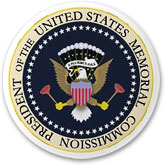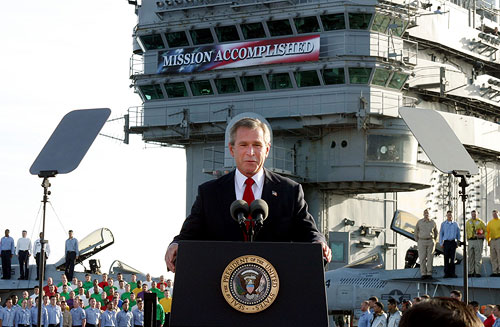June 2008
Méndez was a founder and leader of the Taller de Gráfica Popular.

 Who needs a library for books? The Presidential Memorial Commission of San Francisco proposes to rename a sewage plant after President Bush as a monument to his work. See this brief interview on SFist or coverage in the SF Gate. The group is collecting signatures to put the initiative on the city ballot in November.
Who needs a library for books? The Presidential Memorial Commission of San Francisco proposes to rename a sewage plant after President Bush as a monument to his work. See this brief interview on SFist or coverage in the SF Gate. The group is collecting signatures to put the initiative on the city ballot in November.
Forms of Control
From Jan van Toorn, Introduction, Design beyond design: critical reflection and the practice of visual communication:
“Design has become the instrument par excellence for the achievement of social cohesion through form — form as surface, a casing in which an apparent social consensus is created that hides the reality of the cultural condition in a reassuring and entertaining manner.…
In the case of visual journalism and communication design, this means adaptation to the social relations of power, collaborating with and promoting the depoliticization of the media through the primacy of aesthetics as beauty, of visual and other rhetoric that erodes the promise of democracy and participation. The main consequence of all this is that we live in a world in which, to quote Rem Koolhaas, ‘the reality of the socio-economic condition is camoflaged by the decorative glorification of the inevitable.’”
Map Website Visits
One frequent request from users of my little Flash map is a way to map traffic to their website. So here it is. The map above displays a week of traffic to the map home page.
I adapted the geocounter PHP script to query the hostip.info API and convert IP address to latitude and longitude and store the location in a database.
There are a few tools that map traffic by adding dots to a PNG or markers to an embedded Google map, but I find these cluttered and cumbersome. My map does a few things differently:
- With a single click, zoom into a cluster of points to see a finer, more detailed view. No more bouncing to Google or fiddling with a lot of navigation buttons. You can also click-and-drag to zoom into a specific selection, or click on the edge of the frame to move around.
- Additional traffic increases the total area of the dots proportional to the number of hits you get, not just doubling diameter with each subsequent hit.
- Points fade over time as the traffic record ages.
- Traffic from the same location over multiple days is represented by concentric circles, older visits shown in outer rings that fade over time.
- You can customize colors of the points, background, countries and borders. For instance, see darker, analog-style version on the map home page.
- You can configure the how long you want to store traffic data, and the minimum size of the points.
The geocounter script is GPL’ed and the map is free for personal or non-profit use, but requires a license for commercial use. For more information visit http://backspace.com/mapapp/.
Download the PHP scripts and world map at http://backspace.com/mapapp/geocounter.zip.
It's been thrilling watching traffic show up from far-flung places. Sort of takes me back to the old web odometer days. Enjoy!

Bigger Better Bottle Bill
 Yesterday the New York State Assembly passed legislation to update the State’s “Bottle Bill”... with the “Bigger Better Bottle Bill.”
Yesterday the New York State Assembly passed legislation to update the State’s “Bottle Bill”... with the “Bigger Better Bottle Bill.”
The bill (A-8044-A/Sweeney) expands the five-cent bottle deposit and refund to include non-carbonated beverages such as bottled water, iced teas and sports drinks. Unredeemed deposits will help fund New York’s Environmental Protection Fund. The old bottle bill did not require deposits on non-carbonated beverage containers, nor did it mandate that revenues from unclaimed deposits be paid to the State. Bottled water, teas, juices and sports drinks didn’t much exist when the initial law was passed in 1982, but have since grown to 25% of the market.
From the bill’s accompanying memo:
“New York’s ‘bottle bill’ is one of the State’s most successful recycling and anti-litter initiatives. There is less litter and broken glass in our streets, farm fields, playgrounds, parks and beaches as a result of the bottle bill. It has also reduced the burden of solid waste disposal that is shouldered by local governments and taxpayers.
Since the enactment of the original bottle bill in 1982, non-carbonated beverages such as bottled water, juices, teas and sports drinks have become extremely popular. Millions of bottles and cans from such beverages end up in the trash or littering the environment because consumers lack an incentive to recycle such containers.
Updating the bottle bill to include non-carbonated beverages will provide an incentive to make our environment cleaner and safer by increasing recycling. By requiring beverage companies to provide unclaimed deposits to the State for deposit into the EPF, the bill will also generate new funding for State and local environmental programs. It is estimated that expansion of the bottle bill will result in at least $100 million for deposit into the EPF.”
Watch a two minute video overview on YouTube from the Surfrider Foundation.
The bill was passed unanimously in the Assembly, but faces opposition in the State Senate. The law is opposed by big beverage corporations, grocers and liquor store owners who anticipate higher operating costs. On the other hand, the bill has an impressive list of supporters. NYPIRG has a campaign page up at http://www.nypirg.org/enviro/bottlebill.
Bottlebill.org tracks container deposit laws around the world that require a minimum refundable deposits on beverage containers.
Do Artifacts Have Politics?
After much searching I finally found an electronic version of this essay via a dead link and archive.org. I’m posting here to save it from the memory hole — and have fixed the HTML formatting in the process.
By Langdon Winner, from The Whale and the Reactor: A Search for Limits in an Age of High Technology. Chicago: University of Chicago Press, 1986. 19-39. This essay first appeared in Daedalus 109 (1980): 121-36.
No idea is more provocative in controversies about technology and society than the notion that technical things have political qualities. At issue is the claim that the machines, structures, and systems of modern material culture can be accurately judged not only for their contributions to efficiency and productivity and their positive and negative environmental side effects, but also for the ways in which they can embody specific forms of power and authority. Since ideas of this kind are a persistent and troubling presence in discussions about the meaning of technology, they deserve explicit attention.
Writing in the early 1960s, Lewis Mumford gave classic statement to one version of the theme, arguing that "from late neolithic times in the Near East, right down to our own day, two technologies have recurrently existed side by side: one authoritarian, the other democratic, the first system-centered, immensely powerful, but inherently unstable, the other man-centered, relatively weak, but resourceful and durable."1 This thesis stands at the heart of Mumford’s studies of the city, architecture, and history of technics, and mirrors concerns voiced earlier in the works of Peter Kropotkin, William Morris, and other nineteenth-century critics of industrialism. During the 1970s, antinuclear and pro-solar energy movements in Europe and the United States adopted a similar notion as the centerpiece of their arguments. According to environmentalist Denis Hayes, "The increased deployment of nuclear power facilities must lead society toward authoritarianism. Indeed, safe reliance upon nuclear power as the principal source of energy may be possible only in a totalitarian state." Echoing the views of many proponents of appropriate technology and the soft energy path, Hayes contends that "dispersed solar sources are more compatible than centralized technologies with social equity, freedom and cultural pluralism."2
Mission Accomplished
The May 2003 image of President Bush on the deck of the aircraft carrier in front of the “Mission Accomplished” banner is, I think, one of the more memorable images from the war in Iraq. Primarily, of course, because no weapons of mass destruction were ever found (our mission, right?), the war rages on and US and Iraqi lives continue to be lost. Every day.
But there’s another story behind the image and Bush’s statement about the end of “major combat operations in Iraq.”

Below, a quote from Philip Gourevitch in conversation with Errol Morris at the 2007 New Yorker festival:
“One of the legal fictions of this period, you may think that the May 1st declaration by the President on the aircraft carrier that major combat operations had ended was merely a campaign period photo op. But in fact, it’s a redefinition of the theater of war.
During a war, you’re fighting against an enemy power and if you capture their people they’re enemy POWs and there are all kinds of rules that apply, but they’re never going to be charged with a crime. They’re simply treated as enemy combatants, enemy assets that you’re neutralizing, you remove them to the rear and as soon as combat’s over you release them. And believe it or not, May 1 of 2003 a lot of them were released. And a lot of them were kept as ‘security detainees,’ this fictitious word for prisoners. It’s a euphemism.
And the reason they were able to keep them in Abu Ghraib was because, of course, you can’t have a combat zone in a non-combat zone. And you can’t have enemy prisoners of war to whom you apply prisoner of war doctrine in a place where there is no enemy power and where there is no alternate army. So you can’t say to whom they belong and so they must be ‘insurgents.’ Insurgents against what? There isn’t an Iraqi government. So it’s a very complicated legal status, and its these loopholes that are being exploited for simply rounding people up and tossing them in there.”
And Abu Ghraib is, of course, where some of those other memorable photos were taken.

